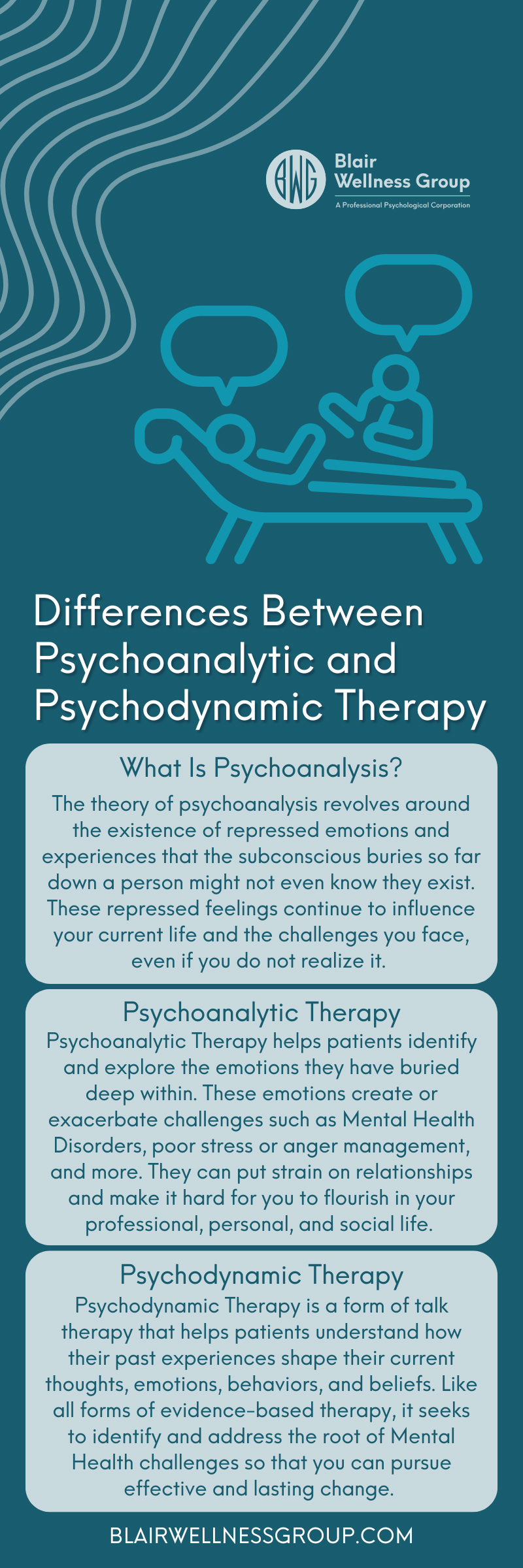There are many evidence-based therapies that can help people with Mental Health Disorders process negative experiences, restructure their thought patterns, and improve their mental and emotional well-being. Because all therapies share this same goal of improving Mental Health, there is extensive overlap between different therapy styles.
This is especially true for Psychoanalytic Therapy and Psychodynamic Therapy—two evidence-based treatment models that come from the theory of psychoanalysis. However, these therapies are still distinct options that have different techniques, ideas, and results. Explore the differences between Psychoanalytic and Psychodynamic Therapy with this guide.
What Is Psychoanalysis?
Both Psychoanalytic Therapy and Psychodynamic Therapy stem from Sigmund Freud’s principles of psychoanalysis. The theory of psychoanalysis revolves around the existence of repressed emotions and experiences that the subconscious buries so far down a person might not even know they exist. These repressed feelings continue to influence your current life and the challenges you face, even if you do not realize it. According to psychoanalysis, the only way to regain control over your thoughts and feelings is to uncover, address, process, and release these repressed emotions. Once you do so, you will be able to build a healthier life for yourself.
Though both Psychoanalytic and Psychodynamic Therapy share the same root of psychoanalysis, they are different from each other and from traditional psychoanalysis therapy.
Psychoanalytic Therapy
Psychoanalytic Therapy helps patients identify and explore the emotions they have buried deep within. These emotions create or exacerbate challenges such as Mental Health Disorders, poor stress or anger management, and more. They can put strain on relationships and make it hard for you to flourish in your professional, personal, and social life.
Repressing these emotions is a natural instinct and a common defense mechanism. However, learning how to overcome this repression is the key to working through past pain and trauma, healing from Mental Health challenges, and building a more stable and positive life.
Psychoanalytic Therapy differs from psychoanalysis in many ways. Traditional psychoanalysis was an intense form of therapy that took place over several years. Many of the practices and details have since proven less effective than psychologists believed them to be at the time.
Today, Psychoanalytic Therapy involves processing repressed emotions. Patients work with a Licensed Clinical Psychologist to gain a clearer perspective over their own past and present and achieve greater control over their thoughts, feelings, and actions.
Techniques in Psychoanalytic Therapy
Psychoanalytic Therapy uses a variety of techniques to help patients uncover and process buried emotions and experiences. These techniques balance traditional theories of psychoanalysis with evidence-based interventions to create a path toward awareness, lasting change, and relief.
Free Association
The goal of free association is to give a patient space to talk through their thoughts and emotions without rules, expectations, or limitations. This removes the pressure of saying the right thing or explaining yourself perfectly. Without those restrictions, it is easier to acknowledge or reveal inner thoughts and feelings—even if you do so without realizing it.
Dream Interpretation
Dreams can offer insight into subconscious thoughts and desires. By reviewing and analyzing dreams with a client, a Licensed Clinical Psychologist can identify hidden emotions that a client struggles to voice or understand on their own.
Transference
Transference is the process of projecting one’s feelings about a specific person onto a different person. In Psychoanalytic Therapy, this typically takes the form of the patient transferring emotions about someone in their life onto their psychologist. Transference highlights specific thoughts, emotions, and relationship dynamics, making it easier for both the patient and their psychologist to analyze and understand the patient’s current situation and relationships.
Uses for Psychoanalytic Therapy
Licensed Clinical Psychologists use Psychoanalytic Therapy alone or alongside other evidence-based therapies to treat Mental Health Conditions and other challenges. Psychoanalytic Therapy has proven effective in the treatment of Anxiety Disorders, Addiction Disorders, Personality Disorders, Depressive Disorders, Post-Traumatic Stress Disorder, relationship issues, stress management, and more.
Psychodynamic Therapy
Psychodynamic Therapy is a form of talk therapy that helps patients understand how their past experiences shape their current thoughts, emotions, behaviors, and beliefs. Like all forms of evidence-based therapy, it seeks to identify and address the root of Mental Health challenges so that you can pursue effective and lasting change.
Through Psychodynamic Therapy, you learn how to identify thought patterns, understand where they came from, and analyze how they affect your life. With this information, you can correct negative thoughts and maladaptive behaviors, which allows you to build more positive thoughts and habits.
Goals of Psychodynamic Therapy
The goal of Psychodynamic Therapy is to improve self-awareness and deepen your understanding of the thoughts, feelings, and beliefs you have surrounding your past experiences. Through Psychodynamic Therapy, Licensed Clinical Psychologists help their patients unlock the unconscious thoughts and emotions influencing their current lives.
Uses of Psychodynamic Therapy
Psychodynamic Therapy is an effective part of treatment plans for many different Mental Health Disorders, including:
- Depressive Disorders
- Post-Traumatic Stress Disorder
- Anxiety Disorders
- Substance Abuse Disorders
- Addiction Disorders
- Anger Management
- Intimacy Issues
- Attachment Disorders
- Eating Disorders
- Personality Disorders
In addition to these Mental Health Conditions, Psychodynamic Therapy can help with relationships, self-image, problem solving, and other aspects of your personal and professional life.
Building Healthier Relationships
Repressed feelings can lead to maladaptive defense mechanisms, which create challenges and barriers in your relationships. These factors negatively affect your ability to communicate, show vulnerability, and create strong emotional bonds with another person. Through Psychodynamic Therapy, you can work through these maladaptive behaviors, improve emotional availability, and create a stronger foundation for your relationships.
Mentalization, Social Causality, and Understanding Yourself and Others
When you understand your own thoughts, feelings, and behaviors, it is easier to understand the actions of other people. Psychodynamic Therapy teaches you why you feel, do, or say certain things. This in-depth personal analysis helps improve your image of yourself, making you more open to understanding and engaging with others in a healthy manner.
Start Your Treatment Plan With Blair Wellness Group
At Blair Wellness Group, we know that every patient requires unique, compassionate care tailored to their specific experiences. Dr. Blair is a Licensed Clinical Psychologist well-versed in Psychoanalytic and Psychodynamic Therapy. If you are looking for an Psychoanalytic Therapist offering effective Mental Health treatment, contact Blair Wellness Group to see how our evidence-based treatment plans can help you.

Dr. Cassidy Blair is a renowned Licensed Clinical Psychologist and trusted Performance Coach who specializes in providing Concierge-Psychological Care and Executive Coaching for high-achieving professionals. With a deep understanding of the unique challenges faced by CEOs, executives, entrepreneurs, and leaders, Dr. Blair offers tailored, confidential care designed to foster emotional well-being, personal growth, and professional excellence. Her clientele values her discretion, clinical expertise, and emotionally intelligent approach to navigating complex personal and professional dynamics.
- This author does not have any more posts.








